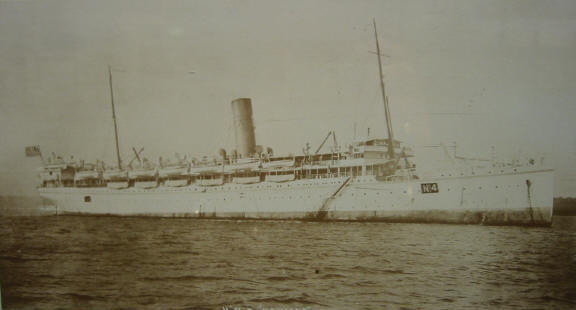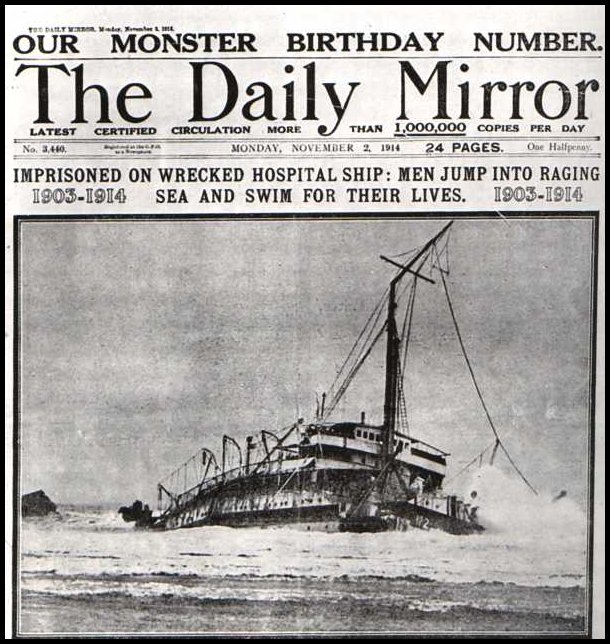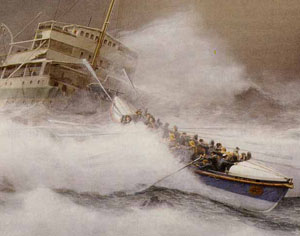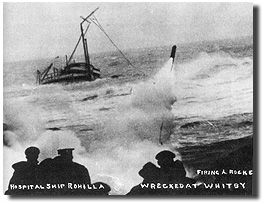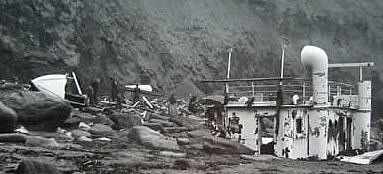| 1. Hospital Ships | 2. Rohilla Story | 3. Home | 4. Questions |
|
The Rohilla story
The SS Rohilla was built and launched by Harland and Wolff shipbuilders in Belfast . Although launched on the 6 th September 1906 , shed wasn't delivered to the British Indian Steam Navigation Co. Ltd until 17 November 1906 . The SS Rohilla was named after Afghan tribes who had sought refuge in India during the 18 th Century. They ere annihilated by the Nawab of Oudh (with the unauthorised help of British troops). In 1908 the SS Rohilla entered service as a permanent military ship and on the 6 th August 1914 was requisitioned as a Hospital ship and became known as the HMHS Rohilla. She was immediately refitted with the necessary equipment and all her passenger accommodation became hospital wards. She was also fitted with 2 operating theatres. On the 16 th August 1914 , the HMHS Rohilla departed from Southampton and sailed to Scappa Flow to start training. Whilst there Prince Albert had developed an appendicitis whilst onboard the HMS Collingwood . Captain David Landles Neilson commanded the HMHS Rohilla. His orders were to transport Prince Albert to Aberdeen where Royal Surgeons would rendezvous with them. On the 29 th October 1914 , the Rohilla set sail for what would be her last voyage. She began to sail down the East Coast of England. Captain Neilson was unfamiliar with the waters. It was unknown whether there would be enemy submarines or mines in the area. To make matters worse the weather had started to deteriorate. By the time the Rohilla approached the northern side of Whitby , the weather was blowing gale force. Albert Jefferies, the Whitby Coastguard saw that the course of the Rohilla was heading directly into the rocky coastline (or “Whitby Rock” as it is called). Jefferies tried to signal the Rohilla using Morse code but did not get a response. The crew aboard the Rohilla had no idea of the dangers that they were travelling towards. The Rohilla struck the rocks near Saltwick Nab at 4 am 29 October 1914 .
Captain Neilson thought that the ship had hit a mine but he had to make a decision as to how to handle the accident. He could either run the ship aground trying to save as many lives as possible or he could stop the ship and hope that the gale conditions would not prevent a speedy evacuation. He chose to run the ship aground. Within a few minutes (if that) the ship hit a large rock platform sealing the fate of the ship. She struck the rock with such force that the infrastructure fractured in two places. It would only be a matter of time before the stern part of the ship would collapse into deeper waters. The coastguard fired rockets to alert the rescue services. Even the Rohilla was only 500 yards away from the shore her position was problematic for the resue services. The gale force winds continued to lash at the ships' side.
The Rocket Brigade started the rescue operation. They were equipped with rockets and a Boson's Chair. In rescue operations, a line would be attached to a rocket and fired over the vessel in trouble. The survivors on the Rohilla would have caught the line and tied it to something strong and secure making the line taught. A Boson's chair would be fitted to the line and passengers would be transported one by one to safety. Unfortunately three rockets were fired but failed to reach the Rohilla. The Rohilla carried 229 people. The rescue attempt had to intensify. The Rohilla was taking quite a pounding from the waves. Survivors were slowly been washed over the side of the ship. If this happened it was very unlikely that they would survive because the choppiness of the waves would dash a person on the rocks killing them instantly. Conventional lifeboats were ineffective because the sea was too rough. It took five and a half hours before one boat reached the doomed ship and rescued 17 people.
A second attempt was made rescuing a further 18 passengers. The lifeboat was severely damaged and was abandoned. By Friday there were still about 40 passengers onboard the ship. The waves were still pounding the side of the ship. Many locals had gathered on the cliff tops to witness the horrific rescue scent. People were helpless. The poop deck of the Rohilla collapsed into deeper water, out of sight. On Saturday, the gale continued to rage. The rescue attempt needed a motorised lifeboat. The nearest one was located at Teesside. The Henry Vernon left Tyneside at 4.15 PM . It had to sail down the coat to Whitby . On Sunday the Henry Vernon arrived on the scene and rescued the remaining passengers still stuck on the ship.
The Rohilla InquestThe jury found that in the light of the storm, absence of lights and usual safeguards, Captain Neilson was not responsible for the disaster. However, it was never explained why the ship was seven miles off course. The jury recommended that passenger liners should be supplied with rocket apparatus so that the stricken ship could fire the line to the shore almost guaranteeing being picked up by rescuers. The jury also recommended that a motorised lifeboat should be provided for Whitby .
|
